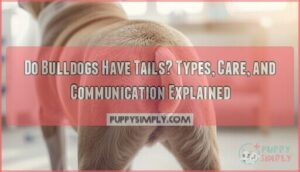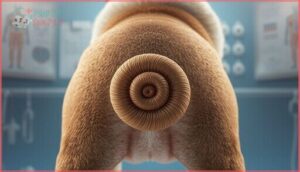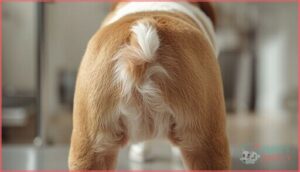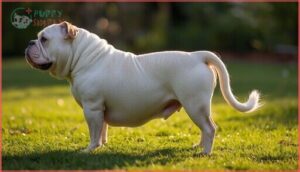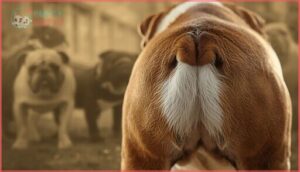This site is supported by our readers. We may earn a commission, at no cost to you, if you purchase through links.
You might think bulldogs are born without tails, but that’s not quite right. Every bulldog comes into the world with a tail, though you’d be forgiven for missing it at first glance. These compact, muscular dogs carry tails so short and tucked that they barely peek out from their rumps.
The DVL2 gene is responsible for this distinctive feature, causing fewer tail vertebrae to develop and creating the characteristic shapes you’ll see across the breed. Some bulldogs sport straight stubs that hug their bodies, while others have corkscrew tails that spiral tightly downward.
Understanding your bulldog’s tail type isn’t just about breed trivia—it directly impacts the care routines you’ll need to keep your dog healthy and comfortable.
Table Of Contents
- Key Takeaways
- Bulldogs Are Not Born Tailless
- Tail Length and Coccygeal Vertebrae
- The Four Main Bulldog Tail Types
- Why Bulldogs Have Such Short Tails
- How to Care for Your Bulldog’s Tail
- Are Bulldog Tails Ever Docked?
- How Bulldogs Communicate Without Long Tails
- Frequently Asked Questions (FAQs)
- How do corkscrew tails impact a bulldog’s ability to balance?
- How does a bulldog’s tail help it communicate with other dogs?
- What is the role of the tail in a bulldog’s overall body language?
- Can bulldogs injure their tails during play?
- Do bulldog tail types affect their spine?
- Are certain tail types more prone to infections?
- Can bulldogs be born with no tail at all?
- Do bulldog puppies tails change as they grow?
- Conclusion
Key Takeaways
- Every English Bulldog is born with a tail, though the DVL2 gene causes them to have only 5 to 13 coccygeal vertebrae instead of the typical 20 to 23, resulting in tails under 2 inches long that appear as straight stubs, corkscrews, or tight curls.
- The corkscrew tail type, present in about 75% of bulldogs, creates deep tail pockets that require daily cleaning with antiseptic wipes to prevent chronic bacterial infections, dermatitis, and in severe cases, surgical tail amputation.
- Bulldogs communicate primarily through full-body wiggles, facial expressions, and vocalizations rather than traditional tail wagging, with over 80% of owners reporting the distinctive “butt wiggle” as their dog’s main way of expressing joy and friendliness.
- Tail docking is not part of bulldog breed history since their naturally short tails result from selective breeding practices, though medical tail removal may become necessary when persistent infections don’t respond to treatment.
Bulldogs Are Not Born Tailless
Your bulldog wasn’t born without a tail, even though you might barely see one. Every English Bulldog comes into the world with a tail, though breeding practices have shaped what that tail looks like. The DVL2 gene, present in 100% of bulldogs studied, determines their distinctive tail morphology. This genetic predisposition means your dog’s tail is naturally short or uniquely shaped, not removed.
Most bulldogs show either a straight, tight-against-the-body tail or those distinctive corkscrew tails that curl downward. Tail docking isn’t part of the breed’s history, and those tiny tail pockets you might notice are completely natural. The phenotype expression you’re seeing is intentional, passed down through generations of selective breeding.
Understanding tail types helps you recognize what’s normal for your bulldog and what needs attention. Like French Bulldogs, selective breeding has led to the emphasis on specific physical traits in bulldogs.
Tail Length and Coccygeal Vertebrae
When you look closely at your English Bulldog’s tiny tail, you’re seeing a structure with far fewer bones than longer-tailed breeds. While usual canine anatomy includes 20 to 23 coccygeal vertebrae, your bulldog has just 5 to 13. That’s a significant reduction, and it directly affects tail length and mobility.
The DVL2 gene variant causes vertebral malformations in these tail bones, leading to the fusion and misalignment you might notice. Most bulldog tails measure under 2 inches, with many barely reaching an inch. Tail docking isn’t the reason for this shortness—it’s purely genetic. The breed standard aims to maintain quality, which includes consideration of physical characteristics.
Here’s what you should know about your bulldog’s tail bone structure:
- Males often have slightly longer tails than females due to size differences
- Screw-type tails typically measure less than 1.5 inches because of kinked vertebrae
- Some bulldogs show only a rudimentary stub despite having vertebrae present
These genetic tail variants can create spinal health risks you’ll want to monitor carefully.
The Four Main Bulldog Tail Types
English Bulldogs display four distinct tail types, and each one affects how you’ll need to care for your dog. While some variations are common, others show up less often depending on genetics and breeding.
Let’s walk through what each tail type looks like and what it means for your bulldog.
Straight Tails
A straight tail is the simplest tail type you’ll see in English Bulldogs, appearing in about 25% of show dogs. This tail conformation features a cylindrical, tapered shape that hangs low without kinks or curls. Genetic markers on chromosome 1 influence this trait, and breed standards recognize it as ideal for the show ring.
Straight tails offer health benefits too, as they’re less prone to skin-fold infections that plague other dog tail types.
Corkscrew (Screw) Tails
Unlike their straight-tailed cousins, about 75% of English Bulldogs feature the distinctive corkscrew tail—a tightly curled, rigid tail caused by a DVL2 mutation affecting vertebral development. This genetic trait creates kinked caudal vertebrae and deep tail pockets prone to skin fold infections.
While striking, these tail folds require vigilant cleaning to prevent dermatitis. In severe cases involving vertebral malformation or chronic infection, surgical amputation may become necessary.
Curly Tails
Often confused with the corkscrew, the curly tail displays a looser, pig-like curl that violates breed standard deviation for English Bulldogs. These tails stem from the same DVL2 mutation but present differently:
- Deep folds create significant tail pocket infections
- Moisture accumulates rapidly, causing Dog tail hygiene problems
- Care challenges demand daily cleaning routines
- Severe cases require surgical interventions when infections persist
Your bulldog’s curly tail needs vigilant English Bulldog tail care to stay healthy.
Long and Wavy Tails (Rare)
You might spot an English Bulldog with a long and wavy tail, but this rare breed variation appears in fewer than 5% of bulldogs due to tail genetics and selective dog breeding. These tails extend beyond the hip joints and wave freely, unlike tight curly tails or corkscrews.
| Tail Variation | Health Advantage |
|---|---|
| Long and wavy | Lower infection risk |
| Easier wavy tail care | Fewer tail pocket issues |
| Better bulldog anatomy | Improved mobility |
Despite genetic traits favoring health, kennel clubs disqualify these tail types from shows, keeping them confined to pet lines rather than breeding programs.
Why Bulldogs Have Such Short Tails
If you’ve ever wondered why your bulldog has such a tiny tail compared to other dogs, the answer lies in selective breeding practices that span more than a century. Breeders deliberately chose dogs with shorter tails to meet specific appearance standards, and over time, this preference became hardwired into the breed’s genetic makeup.
Understanding the genetics, breeding history, and official standards helps explain why your bulldog’s tail looks the way it does.
Selective Breeding and Genetics
You might wonder how English Bulldogs ended up with such stubby tails. Over five centuries, dog breeding practices prioritized specific genetic traits, creating a genetic bottleneck that drastically reduced diversity.
Breed standards demanded short, distinctive tails, but this selective breeding came with health consequences. The DVL2 mutation, now fixed in bulldog lines, affects canine anatomy beyond just the tail, raising ethical concerns about prioritizing appearance over wellbeing.
The DVL2 Gene and Tail Development
The DVL2 mutation is the genetic blueprint behind your bulldog’s distinctive screw tail. This frameshift deletion disrupts WNT signaling pathways, causing vertebral malformations in the caudal region and beyond.
- Nearly 100% of English Bulldogs carry two copies of this recessive DVL2 mutation
- The mutation affects both tail structure and brachycephalic skull shape
- Homozygous dogs average 26 cm tail length with fused, kinked vertebrae
- Health implications include increased airway syndrome and potential heart defects
Breed Standards for English and French Bulldogs
When you enter your bulldog into an AKC show, judges evaluate tail conformation carefully. The breed standard for English Bulldogs and French Bulldogs accepts only straight or screwed tails—short, low-set, with thick roots. Breed club guidelines penalize high-set, curly, inverted, or missing tails as standard tail faults.
Historical tail trends favored longer tails, but selective breeding refined the ideal tail shape seen in dog breeds today.
How to Care for Your Bulldog’s Tail
Your bulldog’s short tail requires regular attention to prevent painful infections and skin problems. The folds and creases around the tail can trap moisture, dirt, and bacteria, making daily cleaning essential.
Here’s what you need to know to keep your bulldog’s tail area healthy and comfortable.
Cleaning The Tail Pocket Properly
Your bulldog’s tail pocket needs careful attention to prevent tail pocket dermatitis.
Here’s how to clean it properly:
- Gently lift the tail and inspect the tail wrinkle for dirt, moisture, or infection signs like redness or odor.
- Use antiseptic wipes or unscented baby wipes to thoroughly clean inside the pocket, removing all debris.
- Pat the area completely dry to prevent bacterial growth and irritation.
If symptoms persist, vet intervention may be necessary.
Weekly Grooming and Hygiene Routine
Beyond tail pocket care, your English Bulldog needs a full dog grooming routine.
Coat brushing should happen weekly to control shedding, while bath frequency stays at every four to six weeks. Nail trimming and ear cleaning both require attention every four to six weeks.
Dental hygiene matters too—brush your dog’s teeth at least three times weekly to prevent periodontal disease and maintain overall dog health and hygiene.
Using Antiseptic Wipes and Creams
When cleaning your bulldog’s tail pocket, choose dog-safe wipe ingredients like chlorhexidine to prevent tail pocket dermatitis and dog skin infections. Here’s your routine for effective tail care and hygiene:
- Use gentle wipes with 3% chlorhexidine once daily for infection prevention
- Apply thin layers of antiseptic cream to irritated areas
- Pat the area completely dry after cleaning
- Follow veterinary guidance if redness or odor persists
Proper cream application and cleaning frequency make all the difference in skin care.
Signs of Infection to Watch For
Even with consistent cleaning, you need to watch for warning signs. Itching and discomfort often show up first—your bulldog might chew at their rear or scoot across the floor. A foul odor signals bacterial overgrowth, while redness and swelling indicate tail pocket dermatitis.
Puppies face a higher infection risk due to extra skin folds. Later symptoms include discharge, hair loss, and behavioral changes requiring immediate infection treatment.
Are Bulldog Tails Ever Docked?
Bulldogs are born with natural tails, not docked ones. Unlike some breeds that historically had their tails shortened for cosmetic reasons, bulldogs don’t need this procedure.
However, there are specific situations where tail removal becomes necessary, and laws around the practice vary depending on where you live.
Natural Tails Vs. Docked Tails
You’ll rarely encounter a docked English Bulldog today, since most keep their natural tails. Here’s what makes them distinct:
- Natural tails show smooth, uninterrupted contours at the tip, shaped by genetics
- Docked tails display sudden, pinched ends from surgical cutting
- Less than 5% of bulldogs worldwide undergo tail docking, mainly for medical reasons
- Breed standards favor natural short tails without requiring docking
- Ethical considerations and animal welfare issues have shifted owner preferences dramatically
Medical Reasons for Tail Removal
When persistent tail pocket infections don’t respond to treatment, your veterinarian may recommend tail amputation to prevent ongoing pain and complications. English Bulldogs face six times greater odds of needing this surgical procedure compared to other breeds, primarily because of chronic infections and dermatitis that develop beneath corkscrew tails.
| Medical Indication | Why Removal Helps |
|---|---|
| Chronic infections | Eliminates infected skin folds permanently |
| Severe dermatitis treatment | Stops recurring inflammation cycles |
| Ingrown tail pockets | Prevents feces contamination and abscess formation |
| Persistent pyoderma | Removes breeding ground for bacteria |
The surgical removal itself involves careful planning, since bulldogs have higher anesthesia risks due to their flat faces. About 27% of bulldogs experience abscess formation after surgery, making infection prevention through pre-surgical antibiotics essential. Post-op care generally includes wound monitoring and temporary changes in how your dog defecates, though most recover well with proper attention.
Laws and Regulations on Tail Docking
While bulldogs naturally have short tails, tail docking controversy has led to strict animal welfare laws worldwide. Over 35 countries now ban cosmetic tail docking procedures, calling them unnecessary mutilation, though working exemptions exist for certain breeds in limited cases.
- International bans: The UK, Australia, and most European nations prohibit docking except for specific working dogs with documentation
- US regulations: Several states like California and New York ban cosmetic docking, requiring veterinary procedures only for medical reasons
- Show restrictions: Many countries bar docked dogs from competitions where entry fees apply, enforcing veterinary standards through registration requirements
How Bulldogs Communicate Without Long Tails
Just because a bulldog’s tail is short doesn’t mean it can’t express itself clearly. These dogs have developed other ways to show excitement, anxiety, or contentment that don’t rely on a long, sweeping tail.
Here’s how bulldogs get their message across without the traditional wag.
The Bulldog Butt Wiggle
When your bulldog’s entire back end wiggles during greetings, you’re seeing canine social signals at work. Because bulldog tails are so short, hindquarter movement compensates for limited tail movement.
Over 80% of English bulldog owners report this butt wiggle mechanics as their dog’s main emotional expression. This full-body wiggling signals friendliness and contentment, making it a key part of bulldog communication and dog behavior.
Over 80% of bulldogs communicate joy through full-body wiggling, compensating for their naturally short tails with enthusiastic hindquarter movement
Body Language Beyond Tail Wagging
Your English Bulldog expresses emotion through subtle dog behavior that doesn’t depend on tail movement. Since canine anatomy limits typical wagging, you’ll notice dog communication through other channels:
- Facial expressions like raised eyebrows, tilted heads, and relaxed “smiles” signal curiosity and contentment
- Postural cues including play bows and body stiffening reveal playfulness or concern
- Vocalizations from cheerful barks to anxious whines communicate specific needs
- Eye signals and movement signals like whale eye or circling express comfort levels
Frequently Asked Questions (FAQs)
How do corkscrew tails impact a bulldog’s ability to balance?
Corkscrew tails in English Bulldogs alter movement mechanics and body banking during turns. Spinal deformities linked to this canine anatomy increase musculoskeletal strain and heighten injury risk. These dog tail problems also affect balance and coordination.
How does a bulldog’s tail help it communicate with other dogs?
Wagging the truth, your English Bulldog’s compact tail poses communication challenges. Limited tail mobility restricts social signaling, so breed adaptations kick in—bulldogs compensate with full-body wiggles, vocalizations, and expressive body language to navigate dog behavior and dog communication effectively.
What is the role of the tail in a bulldog’s overall body language?
Your bulldog’s tail works alongside other body language cues—like ear position, muscle tension, and the famous butt wiggle—to express emotional signaling range and social context cues despite breed-specific communication limitations.
Can bulldogs injure their tails during play?
Yes, your English Bulldog can injure their tail during play, though it’s uncommon. Strains, sprains, or fractures may affect the tail area, especially if there’s previous trauma. Watch for nerve damage signs like pain or discomfort.
Do bulldog tail types affect their spine?
Screw tail risks include vertebrae malformation and spinal alignment issues in bulldogs. Genetic predispositions, especially in corkscrew tails, increase these complications greatly.
Early screening helps detect genetic disorders in dogs before symptoms appear.
Are certain tail types more prone to infections?
Bulldogs with corkscrew tails face up to 49 times higher infection risk compared to crossbreds.
Those tight curls trap moisture and debris, creating ideal conditions for bacterial and yeast overgrowth despite regular cleaning efforts.
Can bulldogs be born with no tail at all?
True taillessness in English Bulldogs is exceptionally rare. While genetic anomalies can cause coccygeal absence, most bulldogs are born with short, visible tails. Complete tail absence remains a rare occurrence, not a breed misconception.
Do bulldog puppies tails change as they grow?
Not dramatically. Your English Bulldog puppy’s tail shape consistency remains from birth, though pigmentation changes and hair density increase. Growth rate slows after four weeks.
However, malformation visibility can become more apparent during the tail development timeline as spinal structures mature.
Conclusion
Like the tip of an iceberg, your bulldog’s tiny tail reveals only part of the story beneath. Yes, bulldogs have tails—short, varied, and genetically distinct. Whether straight, corkscrew, or curly, each type requires attentive care to prevent infection and discomfort.
You’ve learned how these compact canines express themselves through whole-body wiggles rather than dramatic tail wags. Armed with this knowledge, you’re now equipped to recognize your dog’s unique tail type and provide the specialized care it deserves.
- https://tomkingskennel.com/french-bulldog-tail/
- https://www.vettimes.com/news/vets/small-animal-vets/screw-tail-and-tail-fold-pyoderma-medical-and-surgical-updates
- https://pmc.ncbi.nlm.nih.gov/articles/PMC8519842/
- https://www.facebook.com/groups/709559193662133/posts/1254936845791029/
- https://pubmed.ncbi.nlm.nih.gov/24706391/

